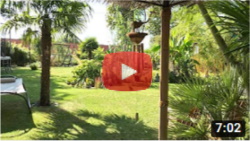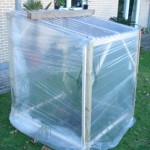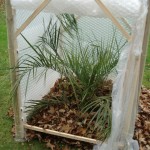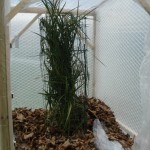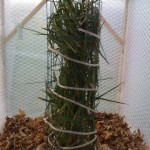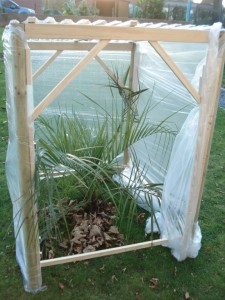 Winter is on the doorstep. It is high time to take the necessary precautions. Now it is still pleasant work outdoors and so not everything has to happen overnight when it suddenly freezes. Firstly, we need to take an inventory. Which plants need protection? Which not? Which methods are there and which are best suited to your needs? Our article about the general winter protection of palms helps you on your way.
Winter is on the doorstep. It is high time to take the necessary precautions. Now it is still pleasant work outdoors and so not everything has to happen overnight when it suddenly freezes. Firstly, we need to take an inventory. Which plants need protection? Which not? Which methods are there and which are best suited to your needs? Our article about the general winter protection of palms helps you on your way.
Palms planted outside in the open
In the case of palm trees in the open, protection must be provided locally. For some species it is sufficient to bind the leaves upwards only when the frost is severe and wrap a little fleece cloth around the stem and leaves. A Trachycarpus fortunei is a good example of this.
But unfortunately many palms are much more sensitive to frost. In that case, more work needs to be done on good protection in order to successfully guide the palm through the winter. The most important thing is to keep the plant dry. After all, moist is enemy number one, certainly in combination with frost.
A solid roof is the first step. Often this is supplemented with side walls of bubble wrap or fleece cloths and a light tube around the palm as a heat source. This way the temperature around the palm can be kept artificially a few degrees higher than the outside temperature.
Below you will find a construction plan of our winter protection for a Butia eriospatha. As you can see a whole investment! Both building and purchasing the materials. But much of this is only a one-time event. After the winter, the protection is only partially disassembled, so that it is easy to reassemble next year. Most materials can be used for this purpose. And don’t forget that thanks to all these efforts, you can enjoy a beautiful palm during the other months.
Some points of attention:
- What are the characteristics of the palm? Keeping a tropical specimen frost-free requires a different approach than a palm that is hardy up to -12°C.
- Use sturdy materials and anchor the protection sufficiently. After all, the building is exposed to all elements for several months. Do not underestimate the wind in particular.
- Insulate and ventilate! The warmth escapes mainly via the top side; so also provide insulation there but ventilate very regularly to prevent mold formation etc. An accessible opening simplifies the work involved.
- Provide a pitched roof. Not only the rain and snow can get away so much better, also the condensation drops on the inside will drive away to the lowest point!
- A thermometer with radio transmitter and remote switch for the heat source are ideal for monitoring and influencing conditions remotely. You don’t have to go outside on cold winter days.
Used materials:
round wooden poles (2 longer, 2 shorter)
wooden slats
pine wood beam
construction film
magnets
plastic corrugated roofing sheet_________________ €40,- local DIY store
4 metres of bubble wrap______________€20,- local garden center
light tube 10m (not LED!)________ €12,- second hand because hard to find. Heating cable will also do!
welded wire fencing___________________ recovered material
Building plan:
- The 2 longest poles are connected to each other at the top side by a sturdy pine beam. Tilt slats ensure that everything stays in place.
- On the underside a crossbar is also mounted at some distance from the ground.
- Both the front and rear poles are then hammered into the ground with their pointed ends.
- Then 2 slats are screwed at the bottom of each frame to connect the front and rear.
- Subsequently, 3 slats are placed on the pine beams at the top, then the corrugated sheet is attached to it.
- Then the sides are sealed with a sturdy plastic. By attaching the plastic with wooden strips, the plastic will not tear quickly. The front side is easy to open to easily reach the palm.
- The inside is covered with insulating bubble wrap. The front side can be rolled up for ease of access.
- The palm leaves are tied up and a the wire fence is put around at some distance.
- Finally, a light hose is wound around the wired fence (no direct contact with the palm due to risk of burns!).
Alternatively, you can also work with stretch film. This is available on a roll from the larger construction markets and via the internet. The big advantage is the low price (€9, – for 300 meters) and easy installation. Knot one end on a pole of the cubicle and then wrap the foil tightly around the cubicle by walking around it several times. The other end is also knotted again. If the temperature drops too much, bubble wrap can be temporarily attached to the outside of the cubicle.


Left with ordinary plastic, right with shrink film
© La Palmeraie




